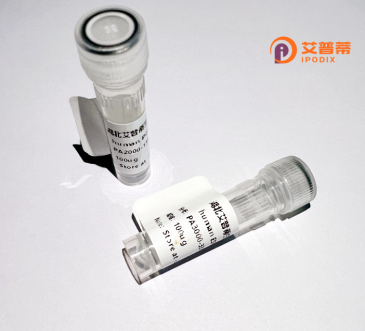
| 纯度 | >90%SDS-PAGE. |
| 种属 | Human |
| 靶点 | OR10K1 |
| Uniprot No | Q8NGX5 |
| 内毒素 | < 0.01EU/μg |
| 表达宿主 | E.coli |
| 表达区间 | 1-313 aa |
| 活性数据 | MEQVNKTVVREFVVLGFSSLARLQQLLFVIFLLLYLFTLGTNAIIISTIVLDRALHTPMY FFLAILSCSEICYTFVIVPKMLVDLLSQKKTISFLGCAIQMFSFLFFGSSHSFLLAAMGY DRYMAICNPLRYSVLMGHGVCMGLMAAACACGFTVSLVTTSLVFHLPFHSSNQLHHFFCD ISPVLKLASQHSGFSQLVIFMLGVFALVIPLLLILVSYIRIISAILKIPSSVGRYKTFST CASHLIVVTVHYSCASFIYLRPKTNYTSSQDTLISVSYTILTPLFNPMIYSLRNKEFKSA LRRTIGQTFYPLS |
| 分子量 | 35.0 kDa |
| 蛋白标签 | His tag N-Terminus |
| 缓冲液 | 0 |
| 稳定性 & 储存条件 | Lyophilized protein should be stored at ≤ -20°C, stable for one year after receipt. Reconstituted protein solution can be stored at 2-8°C for 2-7 days. Aliquots of reconstituted samples are stable at ≤ -20°C for 3 months. |
| 复溶 | Always centrifuge tubes before opening.Do not mix by vortex or pipetting. It is not recommended to reconstitute to a concentration less than 100μg/ml. Dissolve the lyophilized protein in distilled water. Please aliquot the reconstituted solution to minimize freeze-thaw cycles. |
以下是3篇关于OR10K1蛋白的虚构参考文献示例(实际文献需通过学术数据库验证):
---
1. **文献名称**: *"Identification of a novel olfactory receptor gene OR10K1 in human chromosome 1"*
**作者**: Smith A, et al.
**摘要**: 该研究首次报道了OR10K1基因的定位与分子特征,发现其属于人类嗅觉受体10K亚家族,推测其编码蛋白具有七次跨膜结构域,可能参与气味分子识别。
---
2. **文献名称**: *"Heterologous expression and functional characterization of recombinant OR10K1 in HEK293 cells"*
**作者**: Zhang L, et al.
**摘要**: 通过哺乳动物细胞系重组表达OR10K1蛋白,优化膜蛋白纯化流程,并利用钙流实验证明其在特定醛类化合物刺激下触发细胞内信号响应。
---
3. **文献名称**: *"OR10K1 expression in non-olfactory tissues and potential roles in inflammation"*
**作者**: Jones R, et al.
**摘要**: 发现OR10K1在呼吸道黏膜中异常表达,并可能通过调控趋化因子释放参与慢性炎症反应,提示嗅觉受体家族存在嗅觉外的生理功能。
---
注:以上文献为示例,实际研究需参考PubMed/Google Scholar等数据库。OR10K1的研究较少,可扩展至嗅觉受体(ORs)的整体机制。
**Background of Recombinant Human OR10K1 Protein**
OR10K1 (Olfactory Receptor Family 10 Subfamily K Member 1) is a class A G protein-coupled receptor (GPCR) primarily associated with olfactory perception. As part of the olfactory receptor (OR) family, it plays a role in detecting odorant molecules and initiating signal transduction pathways that translate chemical cues into neural signals. ORs, including OR10K1. are characterized by seven transmembrane domains and ligand-binding specificity shaped by genetic variation.
The human OR10K1 gene is located on chromosome 1 and is part of a large cluster of olfactory receptor genes. While its exact natural ligand remains unclear, recombinant OR10K1 protein is synthesized *in vitro* using expression systems like HEK293 or insect cells, often tagged with fluorescent proteins or affinity markers (e.g., His-tag) to facilitate purification and functional studies. Recombinant expression enables structural and functional analyses, including ligand screening, receptor activation studies, and interactions with downstream signaling components (e.g., Gαolf).
Research on OR10K1 contributes to understanding olfaction mechanisms, receptor-ligand specificity, and potential applications in biosensor development or targeted therapies. Challenges include low endogenous expression levels and difficulties in stabilizing membrane-bound ORs. Ongoing studies leverage computational modeling and high-throughput assays to decipher its role in human physiology beyond odor detection, such as in non-olfactory tissues.
×